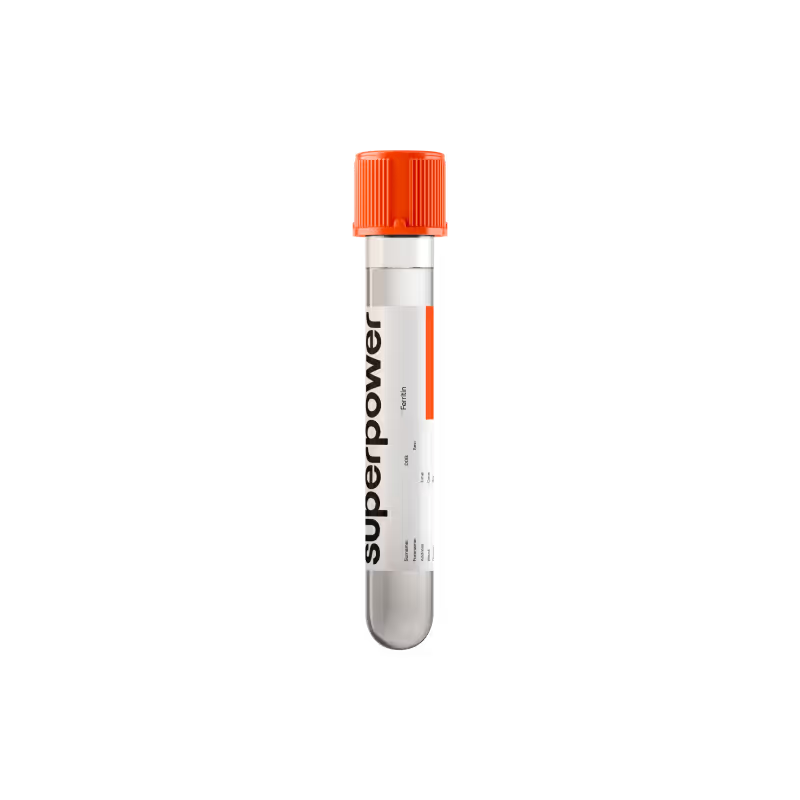
Key Benefits
- See how well your blood transports usable iron to your tissues.
- Spot early iron shortfall; low saturation signals limited iron delivery.
- Flag iron overload risk; high saturation suggests hereditary loading or excess intake.
- Explain fatigue, poor exercise tolerance, or restless legs when iron runs low.
- Guide safe treatment; low supports supplementation, high warns to avoid extra iron.
- Protect fertility; balanced iron supports ovulation and hormones, extremes can impair reproduction.
- Support pregnancy; low saturation highlights higher needs to prevent maternal and fetal anemia.
- Track trends and clarify anemia type with ferritin, complete blood count, and symptoms.
What is Iron Saturation?
Iron saturation is the share of your blood’s main iron carrier that is actually loaded with iron. In scientific terms, it is transferrin saturation (TSAT): the percentage of iron‑binding sites on transferrin (a liver-made transport protein) that are occupied by ferric iron (Fe3+). Transferrin circulates in plasma, picking up iron absorbed from the gut or released from stores and holding it safely in two binding pockets. Iron saturation tells you how full that carrier is at a given moment.
Why it matters: this measure reflects the availability of transport‑ready iron for the tissues that use it most, especially the bone marrow for hemoglobin production (erythropoiesis), as well as muscles and enzymes (myoglobin, cytochromes). It captures the balance between iron supply and the blood’s carrying capacity, indicating how efficiently iron is being shuttled to where it’s needed while kept non‑reactive in transit. In short, it gauges the bloodstream’s iron “traffic load.”
Why is Iron Saturation important?
Iron saturation, often reported as transferrin saturation (TSAT), shows how much of your blood’s iron-carrying protein is actually loaded with iron. It’s a snapshot of iron that’s ready for use—fuel for red blood cell production, muscle work (myoglobin), mitochondrial energy enzymes, neurotransmitter synthesis, thyroid hormone production, and immune defense. Too little available iron limits oxygen delivery and cellular energy; too much promotes oxidative injury in organs.
In adults, typical TSAT values sit around the low-to-mid tens to mid-forties percent, with “healthiest” usually in the middle. Premenopausal women often run lower than men due to menstrual losses, and TSAT commonly dips in pregnancy as transferrin rises and demand increases.
When TSAT is low, it reflects inadequate circulating iron—either true deficiency (blood loss, low intake, poor absorption) or “functional” lack during inflammation, when iron is trapped in storage. The marrow makes smaller, fewer red cells, muscles tire, and the brain may feel foggy; shortness of breath, palpitations, headaches, brittle nails, hair shedding, and restless legs can appear. Children and teens may show attention and learning effects; pregnancy increases fatigue and risk of anemia.
When TSAT is high, iron is oversupplied relative to binding capacity, suggesting overload from hereditary hemochromatosis, repeated transfusions, or acute liver injury. Excess iron deposits in tissues, driving oxidative stress—liver fibrosis, diabetes from pancreatic injury, heart rhythm problems or cardiomyopathy, arthropathy, and hypogonadism; skin may bronze and infection risk can rise.
Big picture: TSAT links iron supply to system-wide energy and organ integrity. Interpreted with ferritin, hemoglobin, TIBC, and inflammation markers, it helps distinguish true deficit from overload and predicts long-term risks to the liver, heart, metabolism, cognition, and quality of life.
What Insights Will I Get?
Iron saturation (transferrin saturation) measures the percentage of iron-binding sites on the blood transport protein transferrin that are filled. It shows how well iron is being delivered to tissues for hemoglobin, mitochondrial energy production, DNA synthesis, thyroid and neurotransmitter pathways, and immune function—core processes for stamina, cognition, cardiovascular health, and fertility.
Low values usually reflect too little available iron relative to transport capacity. This is common with true iron deficiency from blood loss, low intake, poor absorption, or higher demand (menstruation, adolescence, pregnancy). It can also occur in chronic inflammation, where iron is locked in storage (hepcidin effect), producing “functional” deficiency despite normal or high ferritin. System effects include reduced oxygen-carrying capacity, fatigue, lower exercise tolerance, brain fog, restless legs, and in children, risks to growth and neurodevelopment.
Being in range suggests a balanced iron supply to the marrow and tissues without excess. This supports stable red cell production, steady energy, cognition, and thermoregulation. Clinically, optimal tends to sit in the middle of the reference interval.
High values usually reflect iron overload or reduced transferrin. Causes include hereditary hemochromatosis, repeated transfusions, hemolysis or ineffective erythropoiesis, liver disease, and transient post–iron dosing spikes. System effects arise from oxidative stress and iron deposition, affecting liver, heart rhythm and function, endocrine glands, joints, skin, and infection risk.
Notes: Iron saturation is calculated from serum iron and binding capacity, both influenced by time of day, recent iron intake, inflammation, liver status, and hormones. Pregnancy and estrogen therapy raise transferrin and can lower saturation; androgens can raise it. Interpretation is most reliable alongside ferritin, inflammatory markers, and a blood count.




.avif)






.avif)



.svg)





.svg)


.svg)


.svg)

.avif)
.svg)











.avif)
.avif)
.avif)


.avif)
.png)

